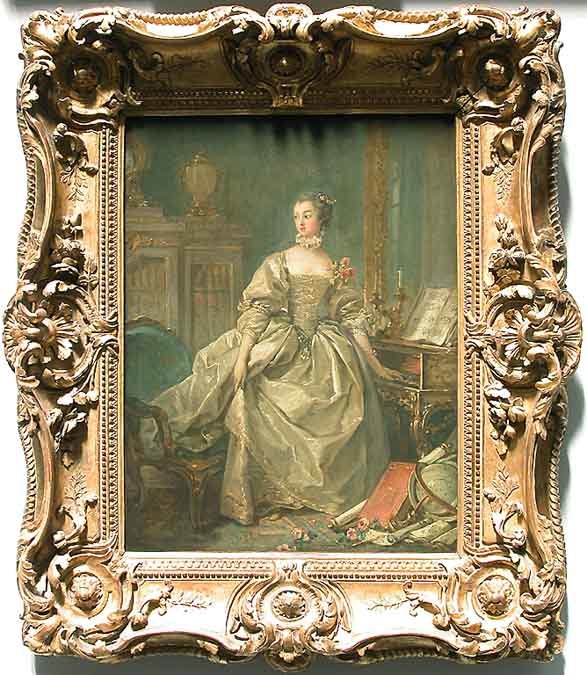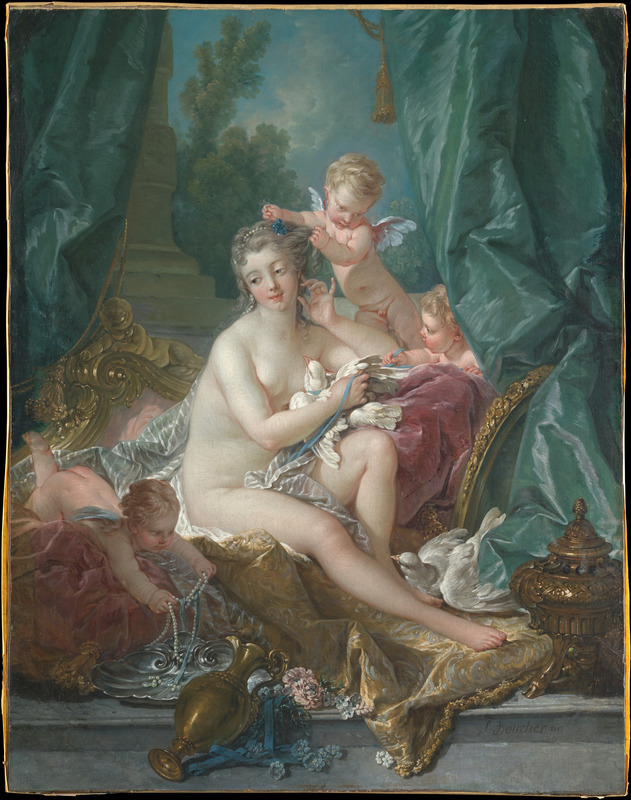Portraiture
During King Louis XIV’s reign, he made paintings about establishing power by establishing the French Academy. The Academy determined careers of artists, the standard of painting, and confined art to certain categories. Often, the most valued academic paintings contained themes of classicism, religion, significant historical events, and portraiture. Much of what Boucher and Fragonard depicted did not fit into these categories, or incorporate themes that would have been considered vital to the monarchy of Louis XIV; however, they did paint significant portraits. The style of painting in his court was telling about how he and other nobility desired to present themselves as to the general public. The article “Representation and the Body of Power in French Academic Painting” by Amy Schmitter describes the career of Charles LeBrun (1619-1690) as the French Academy's director and court painter; he depicted Louis XIV many times. She states that, “the glory and power of Louis means that this would not appear a mere make-over: rather the event, and Louis himself, should immediately produce his own histoire” (409). In other words, by representing the King as an event, as history-in-the-making, he could assert his power in front of whoever viewed the piece.
LeBrun’s Chancellor Seguier at the Entry of Louis XIV into Paris in 1660, he uses the same technique of representation. The chancellor is seated on a horse, a creature which emulates movement, and is surrounded by servants who are in various positions that imply the idea of moving forward. LeBrun incorporates these elements that emulate movement to create the feeling of a moment in time unfolding before a viewer, and one of significance. To expand, the chancellor is positioned above the others in the painting, which implies that he is above them both physically as well as in all other ways: financially, intellectually, etc. Furthermore, he is dressed in a flowing, decadent, gold garment which represents both wealth and power. He has impeccable posture, and looks towards the audience. It is as if, despite all the noble responsibilities he has, he has granted the viewer of the painting the very privilege of eye contact. LeBrun’s choice to: position the chancellor higher, dress him in a decadent garment, and stress his posture all emphasize the idea of significance, glory, royalty, and wealth. However, he also paints it as a historical moment unravelling before the viewer's eyes, as if the chancellor himself embodies history.
In the French court of the eighteenth century, Francois Boucher played a large role. Not only did he define the style of Rococo, but he also represented King Louis XV’s mistress: Madame Pompadour. Mistresses in French government held much power, “As the king's closest confidant and advisor, she often controlled who had access to audiences with Louis XV and sometimes even made public statements on his behalf” (Eschner). Madame Pompadour’s commissioned paintings and portraits depict her power in many different ways.
In the portrait The Marquise de Pompadour, Madame Pompadour wanted her power and beauty to be displayed in a more traditional way. She is painted with delicate, pale skin and flushed cheeks, a common standard of beauty. Additionally, Boucher depicts her in a fashionable, decadent dress. Viewers are able to see everything from the lace on her collar, to the beading on the bodice, to the embroidery towards the bottom. She wears flowers pinned on her shoulder, which symbolize beauty and love. She also gracefully touches the keys of a piano, which perhaps represents her own skill or generous patronage of the arts. All of these details represent her wealth and status as the mistress. However, Boucher still depicts her as captured in a moment of history. She appears to not fully be focused on standing for a portrait, but gazes off to the left of the painting, and her hand looks as if it has just played a few notes. Boucher empowers her by depicting her in motion, as if viewers are watching her essence unfold in front of them.
Madame Pompadour commissioned The Toilette of Venus from Boucher for her washroom, not as a formal portrait. She often collected paintings like this one to lavishly decorate a Rococo interior space. Additionally, she “had performed as Venus in act one of an opera-ballet of that name staged at Versailles in February 1750” (Baetjer). This painting would have reminded Louis XV of her. To expand, compared to The Marquise de Pompadour, the subjects are very similar, both with pale, delicate skin, flushed cheeks, oval faces, and almond-shaped eyes. It is not wholly unfounded to infer that this is a portrait of Madame Pompadour herself. Venus is depicted with cupids, a dove, and flowers, which are all symbols of love and poetry. Also, she is surrounded by luxurious draperies and glimpses of elaborate furniture. Not only is Venus a display of sensual beauty at its finest, but also a display of wealth. Though Boucher chooses a title from antiquity, the painting does not tell a story or provide a moral standard. Instead, its sole value comes from the aesthetics of the material things around Venus. Boucher represents Venus, or perhaps Madame Pompadour, surrounded in wealth and amongst explicit symbols of beauty; she is in a fantasy. She is purely decorative, which shows a complete lack of acknowledgement of the world outside the painting, or citizens living outside of royalty.
Jean-Antoine Fragonard, after being criticized for not meeting royal academic standards, “chose to operate outside the protocols of the Royal Academy, instead working for private patrons, and established his own unique identity” (Schroder 150). In Woman with a Dog, Fragonard is thought to have represented Marie Émilie Coignet de Courson, an aristocrat. She is dressed, much like Madame de Pompadour, in a fashionable dress. Fragonard colors it with pinks and blues, and decorates her with long strands of pearls. Much like the other portraits, Fragonard depicts her in the middle of an action: playing with a dog. However, he presents it beside her, as if making a lighthearted comparison between the woman and her dog. Through more playful colors and comparison, Fragonard depicts her wealth in a lighthearted, humorous way.
In all three of these works, Fragonard depicts aristocrats, even if they are unidentifiable. Most of his portraits were thought to be based on people; however, not completely accurate representations of them. The painting, then, becomes less about who the person is, and more about the idea of the person, specifically, the wealthy person. Wealth as a theme became prominent in Rococo, but one coupled with lightheartedness and the carefree. All of these paintings have a similar positioning of the model, where they are looking to the side and slightly up. This further distances them from the viewer. Additionally, he uses the same playful brushstrokes as in A Woman With a Dog, and plays with different blues, pinks, and oranges in order to create a compelling image to explore with the eye.






